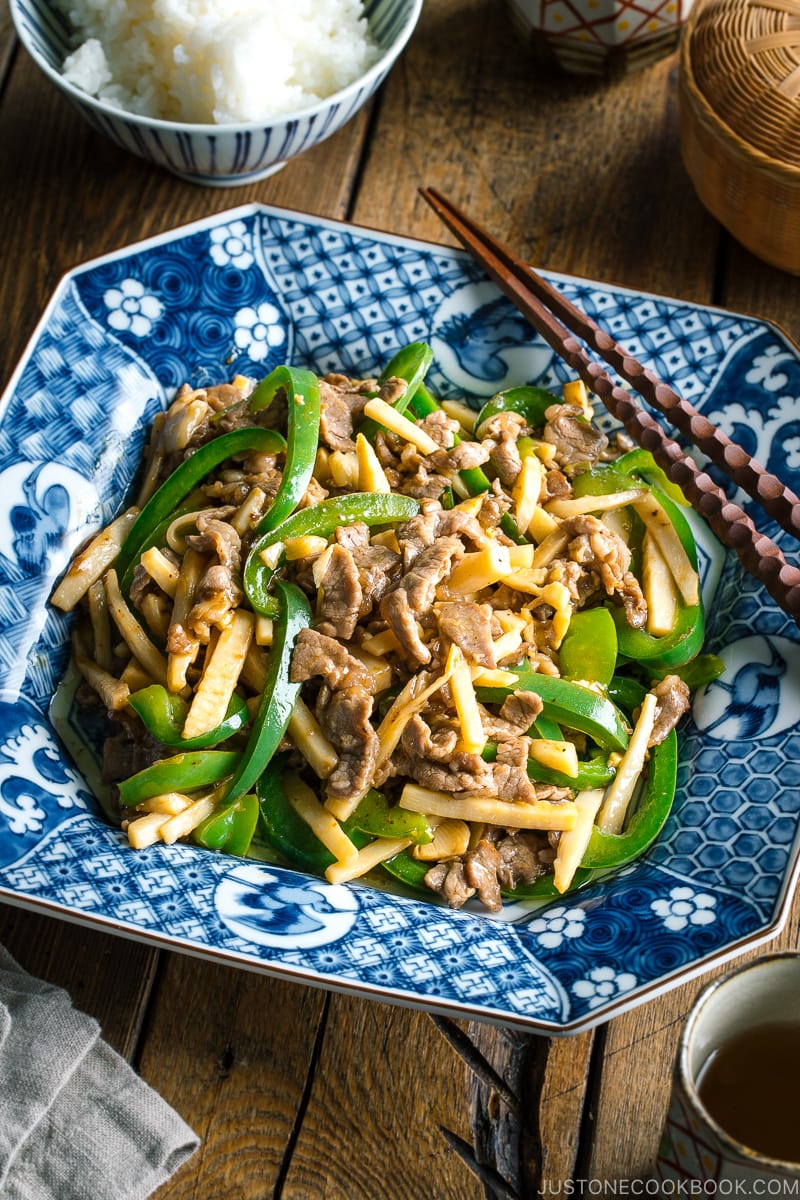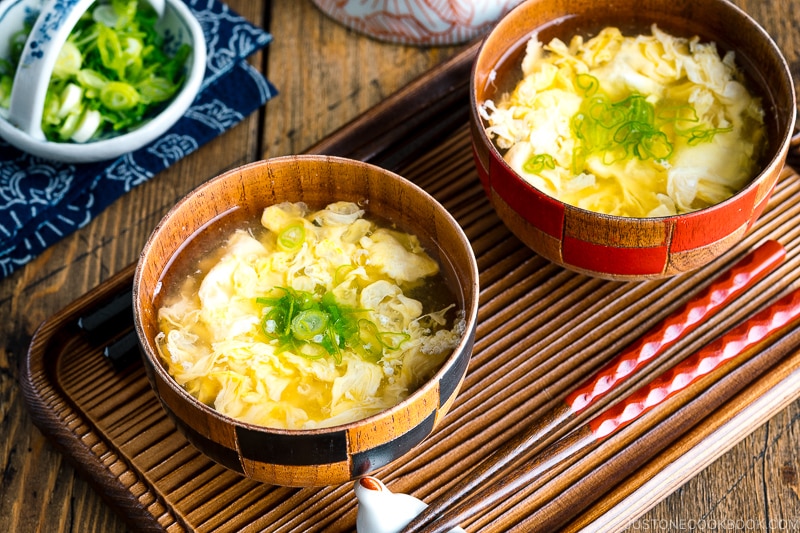Japanese Egg Drop Soup, or Kakitamajiru, is a delicious and homey soup that will warm you right up! Made with dashi broth and fluffy egg ribbons, it is everything you crave in a bowl of soup: delicate, flavorful, and restorative. Ready in 15 minutes!


Soup is a significant part of the Japanese meal, especially when serving Ichiju Sansai (one soup three dishes) during family dinner. The meal typically includes steamed rice, the main protein, a few veggies or side dishes, and a soup.
In addition to the quintessential miso soupwe also enjoy many different types of clear soups. Today I’d like to introduce Japanese Egg Drop Soup or Kakitamajiru (かきたま汁), a flavorful egg drop soup that uses minimal pantry ingredients. It’s quick and simple, and you’re going to love it!
What is Japanese Egg Drop Soup?
You might be more familiar with Chinese egg drop soup (sometimes referred to as egg flower soup) because it is almost a prerequisite in many Chinese restaurants and Asian takeouts. However, did you know that egg drop soup is also common in Japanese home cooking? Both Japanese and Chinese styles are indeed very similar to each other, as they both feature fluffy egg ribbons.
This Japanese version of egg drop soup is known as Kakitamajiru. Feet (掻き) means to scratch, rake, or sometimes includes the stirring motion, and tama (tama) comes from ‘tamago’ (tamago), meaning egg in Japanese. There are (汁) means soup.
Japanese vs. Chinese Egg Drop Soup
Here are some quick generic differences:
Japanese egg drop soup
- Use dashi (Japanese soup stock) as the soup base.
- It has a much lighter consistency, sometimes barely noticeable.
- Use potato starch to thicken.
- Always include soy sauce.
- Garnish with mitsuba (Japanese wild parsley). You can also use scallions as I did in this recipe.
Chinese egg drop soup
- Use chicken broth or chicken stock.
- It has a thick consistency and sometimes turmeric is added for a rich yellow color.
- Use cornstarch slurry to thicken.
- Typical add-ons include julienned ginger, garlic, sweet corn kernels, and sometimes chives as garnish.
- It is flavored with sesame oil and white pepper as the final touches.


Ingredients for Japanese Egg Drop Soup
The best thing about kakitamajiru is that these 5 ingredients are most likely already in your kitchen. I call it my pantry soup!
- Dashi (Japanese soup stock) – You can make homemade Awase Dashi or use a Dashi Packet for a quick shortcut. For a plant-based option, use Kombu Dashi and Vegan dashi.
- Egg(s)
- Potato starch or cornstarch
- I am willow – I use light-colored usukuchi shoyubut you can use regular Japanese soy sauce.
- Sake – A little bit of it adds nice umami.
And pinches of salt to emphasize the flavors and bring everything together.
How to Make Easy Egg Drop Soup
- In a saucepan, add the dashi and seasonings and bring it to a simmer.
- Once simmering, thicken the soup with potato starch mixture.
- Slowly drizzle beaten eggs into the soup. Read the recipe below for detailed tips! Top the soup with chopped green onions and serve immediately.
Various Add-On Ingredients
You can certainly throw in some other ingredients to bulk it up. Here are some common options; however, I recommend keeping the soup rather simple by adding just one additional ingredient besides the egg. The soup is best enjoyed for its simplicity
- Green onion/scallion – I used it in today’s recipe.
- Kaiware daikon radishes
- Japanese mushrooms such as enoki, shiitake, shimeji, etc.
- Wakame seaweed
- Silken/soft tofu
- Julienned carrot
Egg Drop Soup Cooking Tips


- Use good dashi. I understand this is a basic tip, but if you want to make a delicious soup, the base stock is crucial. Here, we use dashi. Avoid using dashi powder when making egg drop soup, as the flavor tends to disappear quickly. Instead, make it from scratch or use a dashi packet.
- Check the flavor of the soup before adding the egg. Oftentimes, when relying on a recipe, you may forget to taste what you’re cooking. It’s important to taste and adjust the taste of the soup before adding the beaten egg. Once the egg is added, do not touch the soup. We don’t want to break the fluffy egg ribbons.
- Whisk the starch mixture one last time before adding to the soup because the starch tends to settle at the bottom of the bowl.
- Drizzle slowly, using a chopstick as a guide. We use a long cooking chopstick as a guide to drizzle the beaten egg from a bowl (or measuring cup). Why drizzle slowly? As soon as the egg hits the hot broth, it should curl up and float. If you pour in too much, the beaten egg becomes heavy and drops to the bottom of the pot. Drizzle slowly as you move across the soup, providing plenty of space for the egg to bloom. Let the egg sit for a few quick seconds, and the soup is ready to be enjoyed!
What to Serve with Egg Drop Soup




You can serve this delicious soup as a light entrée or as a side dish to accompany Chuka Ryori (Japanese-Chinese Dishes) or other Chinese and Asian fares. Here are some of my favorites:
How to Store Egg Drop Soup
You can store the leftover soup in an airtight container in the fridge for up to 3 days. The best way to reheat the soup is to warm it up in a pot on the stovetop until hot, stirring occasionally. If you prefer to microwave the soup, do it in 20-second intervals so the eggs won’t be overcooked.
I don’t recommend storing it in the freezer.
More Delicious Soup Recipes






Wish to learn more about Japanese cooking? Sign up for our free newsletter to receive cooking tips & recipe updates! And stay in touch with me on Facebook, Pinterest, YouTubeand Instagram.


Japanese Egg Drop Soup (Kakitamajiru)
Japanese Egg Drop Soup, or Kakitamajiru, is a delicious and homey soup that will warm you right up! Made with dashi broth and fluffy egg ribbons, it is everything you crave in a bowl of soup: delicate, flavorful, and restorative. Ready in 15 minutes!
Ingredients
Prevent your screen from going dark
Instructions
-
Gather all the ingredients. I recommend making this dish right before you serve.
-
Beat 1 large egg (50 g each w/o shell) in a bowl or measuring cup. Cut 1 green onion/scallion into thin, round pieces.
-
In a small bowl, mix together 2 tsp water and 1 tsp potato starch or cornstarch to make a slurry. As the starch tends to sink to the bottom of the bowl, you will need to mix it again right before you use it.
-
To a saucepan, add 2 cups dashi (Japanese soup stock), 2 tsp sakeand ¼–½ tsp Diamond Crystal kosher salt.
-
Add 1 tsp soy sauce. Check the flavor and adjust with more salt, if needed. Then, bring it to a simmer on medium heat. When simmering, give the slurry mixture another whisk and add it to the dashi.
-
Stir quickly to distribute the slurry into the dashi. Bring it to a simmer.
-
Once simmering (small bubbles will appear around the edges), slowly pour a thin stream of the beaten egg into the soup in circular pattern, starting from the center and spiraling outward (don‘t pour in the same area). Place your cooking chopstick at the edge of the bowl/measuring cup so the egg will drizzle down the chopstick in a thin stream. Let the egg sit for 20–25 seconds. Then, remove the saucepan from the heat to prevent overcooking.
Nutrition
Nutrition Facts
Japanese Egg Drop Soup (Kakitamajiru)
Amount per Serving
% Daily Value*
* Percent Daily Values are based on a 2000 calorie diet.
©JustOneCookbook.com Content and photographs are copyright protected. Sharing of this recipe is both encouraged and appreciated. Copying and/or pasting full recipes to any website or social media is strictly prohibited. Please view my photo use policy here.
Editor’s Note: This post was originally published on February 11, 20221. It was republished with more information on March 4, 2024.

